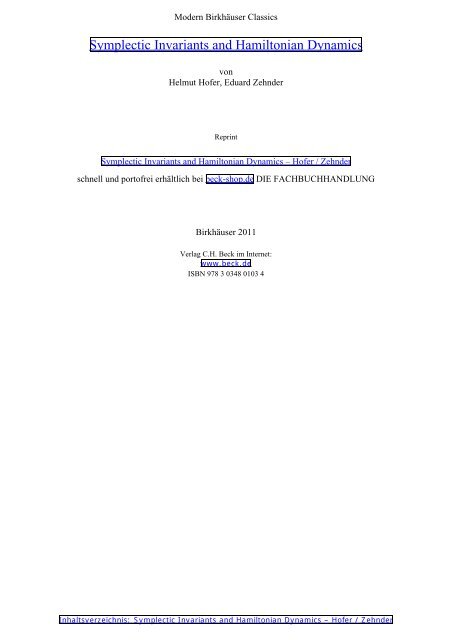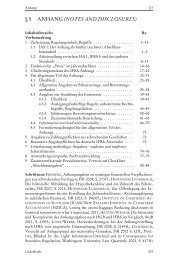Symplectic Invariants and Hamiltonian Dynamics - Hofer / Zehnder ...
Symplectic Invariants and Hamiltonian Dynamics - Hofer / Zehnder ...
Symplectic Invariants and Hamiltonian Dynamics - Hofer / Zehnder ...
You also want an ePaper? Increase the reach of your titles
YUMPU automatically turns print PDFs into web optimized ePapers that Google loves.
Modern Birkhäuser Classics<br />
<strong>Symplectic</strong> <strong>Invariants</strong> <strong>and</strong> <strong>Hamiltonian</strong> <strong>Dynamics</strong><br />
von<br />
Helmut <strong>Hofer</strong>, Eduard <strong>Zehnder</strong><br />
Reprint<br />
<strong>Symplectic</strong> <strong>Invariants</strong> <strong>and</strong> <strong>Hamiltonian</strong> <strong>Dynamics</strong> – <strong>Hofer</strong> / <strong>Zehnder</strong><br />
schnell und portofrei erhältlich bei beck-shop.de DIE FACHBUCHHANDLUNG<br />
Birkhäuser 2011<br />
Verlag C.H. Beck im Internet:<br />
www.beck.de<br />
ISBN 978 3 0348 0103 4<br />
Inhaltsverzeichnis: <strong>Symplectic</strong> <strong>Invariants</strong> <strong>and</strong> <strong>Hamiltonian</strong> <strong>Dynamics</strong> – <strong>Hofer</strong> / <strong>Zehnder</strong>
ter 2<br />
lectic capacities<br />
efinition <strong>and</strong> application to embeddings<br />
llowing we introduce a special class of symplectic invariants discovered by<br />
d <strong>and</strong> H. <strong>Hofer</strong> in [68, 69] for subsets of R 2n . They were led to these inin<br />
their search for periodic solutions on convex energy surfaces <strong>and</strong> called<br />
plectic capacities. The concept of a symplectic capacity was extended to<br />
ymplectic manifolds by H. <strong>Hofer</strong> <strong>and</strong> E. <strong>Zehnder</strong> in [123]. The existence<br />
these invariants is based on a variational principle; it is not intuitive,<br />
be postponed to the next chapter. Taking their existence for granted, the<br />
his chapter is rather to deduce the rigidity of some symplectic embedd,<br />
in addition, the rigidity of the symplectic nature of mappings under<br />
the supremum norm, which will give rise to the notion of a “symplectic<br />
orphism”.<br />
n of symplectic capacity. We consider the class of all symplectic manifolds<br />
ossibly with boundary <strong>and</strong> of fixed dimension 2n. A symplectic capacity is<br />
,ω) ↦→ c(M,ω) which associates with every symplectic manifold (M,ω)<br />
ative number or ∞, satisfying the following properties A1–A3.<br />
otonicity: c(M,ω) ≤ c(N,τ)<br />
xists a symplectic embedding ϕ :(M,ω) → (N,τ).<br />
formality: c(M,αω) =|α|c(M,ω)<br />
∈ R,α = 0.<br />
triviality: c(B(1),ω0) =π = c(Z(1),ω0)<br />
pen unit ball B(1) <strong>and</strong> the open symplectic cylinder Z(1) in the st<strong>and</strong>ard<br />
2n ,ω0). For convenience, we recall that with the symplectic coordinates<br />
2n ,<br />
B(r) =<br />
<br />
(x, y) ∈ R 2n<br />
<br />
<br />
|x| 2 + |y| 2
Chapter 2 <strong>Symplectic</strong> capacities<br />
see later on. We first illustrate the concept <strong>and</strong> deduce some simple conseof<br />
the axioms (A1)–(A3). In the special case of 2-dimensional symplectic<br />
s, n = 1, the modulus of the total area<br />
<br />
c(M,ω) :=| ω |<br />
M<br />
mple of a symplectic capacity function. It agrees with the Lebesgue mea-<br />
R 2 ,ω0). In contrast, if n>1, then the symplectic invariant ( vol ) 1<br />
n is exy<br />
axiom (A3), since the cylinder has infinite volume. If ϕ :(M,ω) → (N,σ)<br />
plectic diffeomorphism between the two manifolds M <strong>and</strong> N, one applies<br />
otonicity axiom to ϕ <strong>and</strong> ϕ −1 <strong>and</strong> concludes<br />
c(M,ω) =c(N,σ).<br />
e, the capacity is indeed a symplectic invariant. Observe also that, by<br />
f the inclusion mapping, we have for open subsets of (M,ω) the monoproperty<br />
U ⊂ V =⇒ c(U) ≤ c(V ).<br />
der to describe some simple examples in (R 2n ,ω0) we start with<br />
1. For U ⊂ (R 2n ,ω0) open<strong>and</strong>λ = 0,<br />
c(λU) =λ 2 c(U).<br />
his is a consequence of the conformality axiom. The diffeomorphism<br />
ϕ : λU → U, x ↦→ 1<br />
λ x<br />
ϕ ∗ (λ 2 ω0) =λ 2 ϕ ∗ ω0 = ω0. Therefore, ϕ :(λU, ω0) → (U, λ 2 ω0) is symplecat<br />
c(λU, ω0) =c(U, λ 2 ω0) =λ 2 c(U, ω0) as claimed. <br />
he open ball of radius r>0inR2n we find, in particular<br />
c(B(r)) = r 2 <br />
c B(1) = πr 2 .<br />
r) ⊂ B(r) ⊂ B(r + ε) for every ε>0 we conclude by monotonicity that<br />
= πr2 . We see that in the special case of (R2 ,ω0)<br />
<br />
c B(r) = c B(r) = area B(r)<br />
ith the Lebesgue measure of the disc. This can be used to show that the<br />
agrees with the Lebesgue measure for a large class of sets in R 2 ,ashas
finition <strong>and</strong> application to embeddings 53<br />
ion 1. If D ⊂ R 2 is a compact <strong>and</strong> connected domain with smooth bound-<br />
c(D, ω0) = area(D).<br />
y removing finitely many compact curves from D, we find a simply conomain<br />
D0 ⊂ D satisfying m(D0) =m(D), which in view of the uniion<br />
theorem is diffeomorphic to the unit disc B(1) ⊂ R2 . Therefore, there<br />
ρ > 0 <strong>and</strong> a diffeomorphism ϕ : B(ρ) → D0 satisfying, in addition,<br />
= m(D0). Given ε>0 we find r0 <strong>and</strong> the result follows. <br />
ly,<br />
0 0, we find by the monotonicity that πr 2 = c(B(r)) ≤ c(U) ≤<br />
πr 2 <strong>and</strong> hence<br />
c(U) =πr 2 . (Fig. 2.1)<br />
demonstrates that very different (in shape, size, measure <strong>and</strong> topology)<br />
s can have the same capacity, if n>1. Recall that the ellipsoids E ⊂ R 2n
U<br />
B(r)<br />
r<br />
Chapter 2 <strong>Symplectic</strong> capacities<br />
Z(r)<br />
s r1(E) ≤ r2(E) ≤ ...≤ rn(E). Applying a linear symplectic map which<br />
s the capacities we may assume, in view of Theorem 9 of Chapter 1, that<br />
B(r1) ⊂ E ⊂ Z(r1) ,<br />
= r1(E). We conclude that the capacity of an ellipsoid E is then detery<br />
the smallest linear symplectic invariant r1(E).<br />
ion 2. The capacity of an ellipsoid E in (R 2n ,ω0) isgivenby<br />
c(E) =πr1(E) 2<br />
ee that every capacity c extends the smallest linear invariants πr1(E) 2<br />
ids E <strong>and</strong> the question arises, whether the linear invariants πrj(E) 2 for<br />
o have extensions to invariants in the nonlinear case. We shall come back<br />
uestion later on. <strong>Symplectic</strong> cylinders are “based” on symplectic 2-planes.<br />
very different from cylinders “based” on isotropic 2-planes on which the<br />
0 vanishes, as for example Z1(r) = (x, y) ∈ R 2n x 2 1 + x2 2 0.<br />
is easily seen as follows. For every ball B(N) there is a linear symplectic<br />
ng ϕ : B(N) → Z1(r). Therefore, πN 2 = c(B(N)) ≤ c(Z1(r)). This holds<br />
every N <strong>and</strong> the claim follows.<br />
der to generalize this example we recall some definitions. If V ⊂ R 2n is a<br />
bspace, its symplectic complement V ⊥ is defined by<br />
V ⊥ = x ∈ R 2n | ω0 (v, x) = 0 for all v ∈ V .<br />
V ⊥ ) ⊥ = V <strong>and</strong> dim V ⊥ =dimR 2n − dim V ,sinceω0 is nondegenerate.<br />
subspace V is called isotropic if V ⊂ V ⊥ ,thatisω(v1,v2) = 0 for all v1<br />
V .<br />
ion 3. Assume Ω ⊂ R 2n is an open bounded nonempty set <strong>and</strong> assume<br />
n is a linear subspace with codim W = 2. Consider the cylinder Ω + W ,<br />
c(Ω + W )=+∞ if W ⊥ is isotropic<br />
⊥<br />
.
finition <strong>and</strong> application to embeddings 55<br />
e may assume that Ω contains the origin. Observe that dim W ⊥ =2.<br />
e, in the second case, W ⊥ is a symplectic subspace <strong>and</strong> R 2n = W ⊥ ⊕ W .<br />
a symplectic basis (e1,f1) inW ⊥ we can, therefore, assume by a linear<br />
ic change of coordinates that<br />
W = {(x, y) | x1 = y1 =0} .<br />
is bounded, we have for z ∈ Ω+W ,thatx 2 1 + y2 1 0, so that the point (x, y) ∈ Ω+W if x2 1 + x22 0<br />
ntly small. Consequently, by the monotonicity of a capacity, c(Ω × W ) ≥<br />
= πR2 . This holds true for every R>0sothatc(Ω + W )=+∞as <br />
w of the monotonicity property, the symplectic invariants c(M,ω) repreparticular,<br />
obstructions of symplectic embeddings. An immediate consef<br />
the axioms is the celebrated squeezing theorem of Gromov [107] which<br />
to the concept of a capacity.<br />
1. (Gromov’s squeezing theorem) There is a symplectic embedding ϕ :<br />
Z(R) if <strong>and</strong> only if R ≥ r.<br />
ϕ is a symplectic embedding, then using the monotonicity property of<br />
city, together with (2.1) <strong>and</strong> (2.2), we have<br />
theorem follows. <br />
πr 2 = c B(r) ≤ c Z(R) = πR 2 ,<br />
next result also illustrates the difference between volume preserving <strong>and</strong><br />
ic diffeomorphisms. We consider in (R 4 ,ω0) with symplectic coordinates<br />
2,y2) the product of symplectic open 2-balls B(r1) × B(r2). By a linear<br />
ic map we can assume that r1 ≤ r2.<br />
ion 4. There is a symplectic diffeomorphism ϕ : B(r1) × B(r2) → B(s1) ×<br />
<strong>and</strong> only if r1 = s1 <strong>and</strong> r2 = s2.<br />
that, in contrast, there is a linear volume preserving diffeomorphism ψ :<br />
(1) → B(r) × B( 1)<br />
for every r>0. As r → 0, we evidently have<br />
r<br />
⎧ <br />
⎪⎨<br />
1<br />
c B(r) × B r → 0<br />
<br />
⎪⎩<br />
1<br />
vol B(r) × B = const.<br />
r
Chapter 2 <strong>Symplectic</strong> capacities<br />
ince r1 ≤ r2 we can use the diffeomorphism ϕ to define the symplectic<br />
ng B 4 (r1) → B(r1) × B(r2) ϕ → B(s1) × B(s2) → B(s1) × R 2 = Z(s1),<br />
e first <strong>and</strong> last mappings are the inclusion mappings. By the monotonicity<br />
conclude s1 ≥ r1. Applying the same argument to ϕ −1 , we find r1 ≥ s1,<br />
r1 = s1. Nowϕ is volume preserving; hence r1r2 = s1s2 <strong>and</strong> the result<br />
<br />
ly, if one assumes that ϕ is smooth up to the boundary, then the conditions<br />
adii follow simply from the invariance of the actions |A(∂B(rj))| = πr 2 j<br />
mplectic diffeomorphism. One might expect the same rigidity as in Propoo<br />
hold also in the general case of a product of n open symplectic 2-balls in<br />
s is indeed the case, but does not follow from the capacity function c alone.<br />
, the proof given in [52] is rather subtle <strong>and</strong> uses the symplectic homology<br />
s developed by A. Floer <strong>and</strong> H. <strong>Hofer</strong> in [90], see also K. Cieliebak, A.<br />
. <strong>Hofer</strong> <strong>and</strong> K. Wysocki [52]. Finally the restrictions for symplectic emof<br />
ellipsoids mentioned in the previous chapter follow immediately from<br />
ion 2.<br />
ion 5. Assume E <strong>and</strong> F are two ellipsoids in (R 2n ,ω0). If ϕ : E → F is a<br />
ic embedding, then<br />
r1(E) ≤ r1(F ) .<br />
xistence of one capacity function permits the construction of many other<br />
functions.<br />
n illustration we shall prove that the Gromov-width D(M,ω) whichap-<br />
Gromov’s work [107] <strong>and</strong> which was explained in the introduction is a<br />
ic capacity satisfying (A1)–(A3). Recall that there is always a symplectic<br />
ng ϕ :(B(ε),ω0) → (M,ω) forεsmall by Darboux’s theorem <strong>and</strong> define<br />
<br />
,ω) =supπr<br />
2<br />
<br />
<br />
there is a<br />
ϕ : B(r),ω0 → (M,ω) .<br />
symplectic embedding<br />
2. The Gromov-width D(M,ω) is a symplectic capacity. Moreover<br />
D(M,ω) ≤ c(M,ω)<br />
capacity function c.<br />
use a compact symplectic manifold (M,ω) has a finite volume we conclude<br />
< ∞ for compact manifolds. This is in contrast to the special capacity<br />
c0 constructed in the next chapter which can take on the value ∞ for<br />
ompact manifolds.<br />
e have already verified the monotonicity axiom (A1) in the introduction.<br />
to verify the conformality axiom (A2), that D(M,αω) =|α|D(M,ω) for<br />
is sufficient to show that to every symplectic embedding
finition <strong>and</strong> application to embeddings 57<br />
responds a symplectic embedding<br />
ˆϕ :<br />
<br />
r<br />
<br />
B |α| ,ω0 → (M,ω),<br />
versely, so that by definition of D, we conclude that D(M,αω) =<br />
ω). If ϕ : (B(r),ω0) → (M,αω) is a symplectic embedding, then<br />
ω0 so that<br />
ϕ ∗ ω = 1<br />
α ω0.<br />
ting ρ = r √ we define the diffeomorphism ψ : B(ρ) → B(r) by setting<br />
|α|<br />
|α|·x <strong>and</strong> find<br />
ψ ∗ 1<br />
α ω0<br />
<br />
= |α|<br />
α ω0.<br />
α>0, the map ˆϕ = ϕ ◦ ψ :(B(ρ),ω0) → (M,ω) is the desired symmbedding.<br />
If α < 0 we first introduce the symplectic diffeomorphism<br />
ρ),ω0) → (B(ρ), −ω0) by setting ψ0(u, v) =(−u, v) for all (u, v) ∈ R 2n ,<br />
the desired embedding ˆϕ = ϕ ◦ ψ ◦ ψ0 :(B(ρ),ω0) → (M,ω).<br />
erification of D(B(r),ω0) =πr 2 is easy. If ϕ : B(R) → B(r) is a symplecdding,<br />
we conclude R ≤ r since ϕ is volume preserving. On the other h<strong>and</strong><br />
tity map induces a symplectic embedding B(r) → B(r) sothattheclaim<br />
Since there exists a symplectic embedding ϕ : B(R) → Z(r) if<strong>and</strong>only<br />
by Gromov’s squeezing theorem, we conclude that D(Z(r),ω0) =πr 2 ,<br />
e Gromov-width satisfies also the nontriviality axiom (A3). In order to<br />
e last statement of the theorem, we assume c(M,ω) to be any capacity.<br />
(r) → M is a symplectic embedding we conclude by monotonicity that<br />
B(r),ω0) ≤ c(M,ω). Taking the supremum, we find D(M,ω) ≤ c(M,ω)<br />
ed in the theorem. <br />
given capacity c one can associate its inner capacity č, defined as follows:<br />
č(M,ω) =sup c(U, ω) | U ⊂ M open <strong>and</strong> U ⊂ M\∂M .<br />
spondingly, we introduce the following<br />
n. A capacity c has inner regularity at M if<br />
č(M,ω) =c(M,ω).<br />
ion 6. The function č is a capacity having inner regularity <strong>and</strong> it satisfies<br />
addition,ifd is any capacity having inner regularity <strong>and</strong> satisfying d ≤ c,
Chapter 2 <strong>Symplectic</strong> capacities<br />
he proof follows readily from the definitions <strong>and</strong> the axioms for capacity.<br />
for example, that d is a symplectic capacity satisfying d ≤ c <strong>and</strong> having<br />
ularity.<br />
ed. <br />
ˇd(M) = sup d(U)| U ⊂ M,U ⊂ M\∂M <br />
≤ sup c(U)| U ⊂ M,U ⊂ M\∂M <br />
= č(M) ,<br />
use it is the smallest capacity, the Gromov-width D(M,ω) has inner reganother<br />
example having this property is the capacity c0 introduced in<br />
3. If we consider subsets of a given manifold we can also define the conuter<br />
regularity (relative to the manifold). The outer capacity of a set is<br />
as the infimum taken over the capacities of open neighborhoods of the<br />
f the given set. We shall return to this concept in the next section.<br />
igidity of symplectic diffeomorphisms<br />
ider a sequence ψj :R 2n →R 2n of symplectic diffeomorphisms in (R 2n ,ω0).<br />
ition, the first derivatives satisfy the identity<br />
ψ ′ j(x) T Jψ ′ j(x) = J, x∈ R 2n .<br />
e, if the sequence ψj converges in C 1 then the limit ψ(x) = lim ψj(x) is<br />
mplectic map. By contrast, we shall now assume that the sequence ψj<br />
verges locally uniformly to a map<br />
ψ(x) = lim<br />
j→∞ ψj(x),<br />
therefore, a continuous map. Since det ψ ′ j (x) = 1 for every x, we find, in<br />
he transformation formula for integrals, that<br />
<br />
f ψ(x) dx = f(x) dx<br />
∈ C ∞ c (R2n ), so that ψ is measure preserving. Assume now that ψ is<br />
iable, then evidently det ψ ′ (x) =±1. However it is a striking phenomenon<br />
even symplectic,<br />
ψ ′ (x) T Jψ ′ (x) = J,<br />
ssumed to be differentiable. Hence the symplectic nature survives under
idity of symplectic diffeomorphisms 59<br />
3. Let ϕj : B(1) → (R 2n ,ω0) be a sequence of symplectic embeddings<br />
ng locally uniformly to a map ϕ : B(1) → R 2n .Ifϕ is differentiable at<br />
enϕ ′ (0) = A is a symplectic map, i.e., A ∗ ω0 = ω0.<br />
ee that, in general, a volume preserving diffeomorphism cannot be apted<br />
by symplectic diffeomorphisms in the C 0 -topology. By using, locally,<br />
charts we deduce immediately from Theorem 3<br />
4. (Eliashberg, Gromov) The group of symplectic diffeomorphisms of a<br />
symplectic manifold (M,ω) isC 0 -closed in the group of all diffeomorf<br />
M.<br />
e early seventies M. Gromov proved the alternative that the group of symiffeomorphisms<br />
either is C 0 -closed in the group of all diffeomorphisms or<br />
osure is the group of volume preserving diffeomorphisms. That symplecmorphisms<br />
can be distinguished from volume preserving diffeomorphisms<br />
l properties which are stable under C 0 -limits was announced in the early<br />
y Y. Eliashberg in his preprint “Rigidity of symplectic <strong>and</strong> contact struc-<br />
981) [78], which in full form has not been published. Proofs are partially<br />
d in Eliashberg [71], 1987. Gromov gave a proof of Theorem 4 in [107]<br />
e techniques of pseudoholomorphic curves. Both Eliashberg und Gromov<br />
the C 0 -stability from non embedding results. In his book [108] Gromov<br />
alled Nash-Moser techniques of hard implicit function theorems, while<br />
rg [71], 1987, uses an analogue of Theorem 3. Following the strategy of<br />
d <strong>and</strong> H. <strong>Hofer</strong> in [68], we shall show next, that Theorem 3 is an easy<br />
nce of the existence of any capacity function c.<br />
convenient in the following to extend the capacity to all subsets of R 2n .<br />
we take a capacity function c given on the open subsets U ⊂ R 2n <strong>and</strong><br />
r an arbitrary subset A ⊂ R 2n :<br />
c(A) =inf c(U) A ⊂ U <strong>and</strong> U open .<br />
e monotonicity property<br />
A ⊂ B =⇒ c(A) ≤ c(B)<br />
e for all subsets of R 2n . From the symplectic invariance of the capacity<br />
sets, one deduces the invariance<br />
c ϕ(A) = c(A)<br />
ery symplectic embedding ϕ defined on an open neighborhood of A.<br />
Theorem 3. Without loss of generality we shall assume in the following<br />
) = 0. We first claim that the linear map ϕ ′ (0) = A is an isomorphism.<br />
because ϕ is differentiable at 0, we have ϕ(x) =Ax + O(|x|), so that for<br />
balls Bε of radius ε>0 <strong>and</strong> centered at 0,<br />
<br />
m ϕ(Bε)
Chapter 2 <strong>Symplectic</strong> capacities<br />
ther h<strong>and</strong>, because the symplectic diffeomorphisms ϕj are volume preserv-<br />
ϕj → ϕ uniformly, we have m(ϕ(Bε)) = m(Bε) <strong>and</strong> hence | det A| =1,so<br />
an isomorphism, as claimed. We shall see later on (Lemma 3) that A is an<br />
ism under weaker assumption: instead of requiring ϕj to be symplectic,<br />
merely require these mappings to preserve a given capacity function.<br />
we claim that to prove Theorem 3, it is sufficient to show that<br />
A ∗ ω0 = λω0 for some λ = 0.<br />
ith ϕj we can also consider the symplectic embeddings (ϕj,id):B(1) ×<br />
R 2n × R 2n ,ω0 ⊕ ω0) <strong>and</strong> hence conclude for the derivative at (0, 0), given<br />
(A, 1), that also Ā ∗ (ω0 ⊕ ω0) =µ(ω0 ⊕ ω0) forsomeµ = 0. On the other<br />
view of (2.4), Ā ∗ (ω0 ⊕ ω0) =(λω0) ⊕ ω0 <strong>and</strong> consequently µ =1=λ, as<br />
in Theorem 4, proving our claim. In order to prove (2.4) we make use of<br />
wing algebraic lemma due to Y. Eliashberg [71].<br />
2. Assume A is a linear isomorphism satisfying A ∗ ω0 = λω0. Thenfor<br />
>0 there are symplectic matrices U <strong>and</strong> V such that U −1 AV has the<br />
U −1 AV =<br />
⎛<br />
⎜<br />
⎝<br />
a 0<br />
0 a<br />
0<br />
∗ ∗<br />
⎞<br />
⎟<br />
⎠ ,<br />
ect to the splitting of R 2n = R 2 ⊕ R 2n−2 into symplectic subspaces.<br />
oning the proof of the lemma, we first show that A∗ω0 = λω0 for some λ =<br />
ng by contradiction, we assume that A∗ω0 = λω0 <strong>and</strong> apply the lemma.<br />
the symplectic maps ψj := U −1ϕjV in the neighborhood of the origin,<br />
lude that ψj → ψ := U −1ϕV locally uniformly, <strong>and</strong> ψ ′ (0) = U −1AV .<br />
a suitable constant a inthelemma,wehaveU−1AV (B(1)) ⊂ Z( 1<br />
8 )<strong>and</strong><br />
−1 ε<br />
ψV (B(ε)) ⊂ Z(<br />
4 )providedεis sufficiently small. Because ψj → ψ<br />
niformly, U −1ψjV (B(ε)) ⊂ Z( ε )ifj is sufficiently large <strong>and</strong> ε sufficiently<br />
2<br />
nce U −1ψjV is symplectic, we conclude by the invariance <strong>and</strong> monotonicerty<br />
of a capacity that c(U −1ψjV (B(ε))) = c(B(ε)) ≤ c(Z( ε<br />
2 )), which<br />
cts the nontriviality Axiom (A3). We have proved the statement in (2.4)<br />
mains to prove Lemma 2.<br />
Lemma 2. Let B be the symplectic adjoint of A satisfying<br />
ω0(Ax, y) =ω0(x, By)<br />
, y, <strong>and</strong> abbreviate ω = B ∗ ω0. Thenω = λω0, as is easily verified using<br />
that A is an isomorphism. We claim that there is an x such that ω(x, ·) =<br />
for every λ. Arguing by contradiction, we assume that for every x, there
idity of symplectic diffeomorphisms 61<br />
ξ, x) = 0, since ω0 is nondegenerate. This remains true for all y in a<br />
hood U(x) ofx. Hence<br />
λ(ξ) ω0(ξ, y) = ω(ξ, y) =−ω(y, ξ)<br />
= −λ(y)ω0(y, ξ)<br />
= λ(y)ω0(ξ, y),<br />
plies that λ(ξ) =λ(y) fory in a neighborhood of x. SinceR 2n \{0} is<br />
d <strong>and</strong> since the function λ(x)onR 2n \{0} is locally constant, it is constant.<br />
e ω(x, ·) =λω0(x, ·) forx = 0 <strong>and</strong> hence for every x. This contradicts the<br />
ion that ω = λω0 <strong>and</strong> proves our claim. Consequently there exists an x<br />
t the linear map (ω0(x, ·),ω(x, ·)) : R 2n → R 2 is surjective. For a given<br />
e therefore find an y satisfying<br />
ω0(x, y) =1<strong>and</strong> ω(x, y) =a 2 .<br />
ω(x, y) =ω0(Bx,By), we can choose two symplectic bases (e1,f1,...)<br />
f ′ 1,...) such that e1 = x, f1 = y <strong>and</strong> e ′ 1 = 1 By. In these bases<br />
Be1 = ae ′ 1 ,Bf1 = af ′ 1 .<br />
aBx,f′ 1 = 1<br />
a<br />
Ax,y〉 = 〈Jx,By〉 = 〈B T Jx,y〉 we read off A = −JB T J.Representing<br />
thenewbasesasamapfromR 2n with basis (e1,f1,...)ontoR 2n with<br />
,f ′ 1,...), we find the representation U −1 AV of the desired form. The<br />
ic matrices are defined by their column vectors as U =[e1,f1,...]<strong>and</strong><br />
f ′ 1 ,...]. <br />
now that symplectic diffeomorphisms preserve the capacities. Theorem 3<br />
efore, be deduced from the following, even more surprising statement for<br />
us mappings due to I. Ekel<strong>and</strong> <strong>and</strong> H. <strong>Hofer</strong> [68].<br />
5. Let c be a capacity. Assume ψj : B(1) → R 2n is a sequence of continppings<br />
satisfying<br />
c(ψj(E)) = c(E)<br />
mall) ellipsoids E ⊂ B(1) <strong>and</strong> converging locally uniformly to<br />
ψ(x) = lim ψj(x).<br />
ifferentiable at 0, then ψ ′ (0) = A is either symplectic or antisymplectic:<br />
A ∗ ω0 = ω0 or A ∗ ω0 = −ω0.<br />
that the mappings are not required to be invertible.
Chapter 2 <strong>Symplectic</strong> capacities<br />
3. Let c be a capacity. Consider a sequence ϕj of continuous mappings in<br />
erging locally uniformly to the map ϕ. Assume that c(ϕj(E)) = c(E) for<br />
ellipsoids for all j. Ifϕ ′ (0) exists it is an isomorphism.<br />
rguing by contradiction, we assume that A is not surjective, so that A(R 2n )<br />
ned in a hyperplane H. Composing, if necessary, with a linear symplectic<br />
may assume that<br />
A(R 2n ) ⊂ H = {(x, y)| x1 =0} .<br />
the linear symplectic map ψ by<br />
ψ(x, y) =<br />
hoose α>0sosmallthat<br />
<br />
ψA B(1)<br />
<br />
1<br />
α x1,x2,...,xn,<br />
<br />
αy1,y2,...,yn<br />
⊂ B 2 ( 1<br />
16 ) × R2n−2 = Z( 1<br />
) ,<br />
16<br />
e open 2-disc B2 on the right h<strong>and</strong> side is contained in the symplectic<br />
th the coordinates {x1,y1}. Be definition of a derivative, we have |ψϕ(x)−<br />
a(|x|) |x| where a(s) → 0ass→ 0. Consequently<br />
<br />
ψϕ B(ε) ⊂ Z( ε<br />
4 )<br />
fficiently small. Since ψϕj converges locally uniformly to ψϕ,<br />
ψϕj<br />
<br />
B(ε)<br />
⊂ Z( ε<br />
) ,<br />
2<br />
j is sufficiently large. By assumption ψϕj preserves the capacity <strong>and</strong> so<br />
tonicity<br />
<br />
c B(ε)<br />
<br />
= c ψϕj(B(ε))<br />
<br />
≤ c Z( ε<br />
2 )<br />
<br />
tradiction shows that A is surjective. <br />
= 1<br />
4 c<br />
<br />
B(ε) .<br />
Theorem 5. We may assume that ψ(0) = 0. By Lemma 3, A = ψ ′ (0) is an<br />
ism <strong>and</strong> we shall prove first that A∗ω0 = λω0 for some λ = 0. Arguing<br />
adiction, we assume A∗ω0 = λω0 <strong>and</strong> find (by Lemma 2) symplectic maps<br />
satisfying U −1AV (B(1)) ⊂ Z( 1 ). Proceeding now as in Theorem 4, we<br />
8<br />
e sequence ϕj := U −1ψjV .Thenϕj→ϕ := U −1ψV locally uniformly,<br />
) = U −1AV . Hence ϕ(B(ε)) ⊂ Z( ε<br />
4 ) <strong>and</strong> consequently ϕj(B(ε)) ⊂ Z( ε<br />
2 )<br />
ciently large <strong>and</strong> ε>0 sufficiently small. Since, by assumption on ψj,<br />
c(ϕj(B(ε))) = c(B(ε)), we infer by the monotonicity of a capacity that
idity of symplectic diffeomorphisms 63<br />
ave demonstrated that A∗ω0 = λω0. By conformality a linear antisymplecpreserves<br />
the capacities. Composing the maps ψj <strong>and</strong> ψ with the symplec-<br />
−1 −1 1 B = √λ 1<br />
A if λ>0 <strong>and</strong> with the antisymplectic map B = √−λA we are therefore reduced to the case<br />
A = α 1, with α>0<br />
ave to show that α =1.Ifα
Chapter 2 <strong>Symplectic</strong> capacities<br />
y. A linear map A in R 2n preserving the capacities of ellipsoids, c(A(E)) =<br />
ither symplectic or antisymplectic.<br />
A ∗ ω0 = ω0 or A ∗ ω0 = −ω0.<br />
be any capacity function <strong>and</strong> consider a homeomorphism h of R 2n satis-<br />
c(h(E)) = c(E) for all (small) ellipsoids E.<br />
h is in addition differentiable, we conclude from Theorem 5 that h is<br />
orphism which is either symplectic or antisymplectic, h ′ (x) ∗ ω0 = ±ω0.<br />
nalogous to a measure preserving homeomorphism, i.e., a homeomorphism<br />
g (2.3). Here we conclude that det h ′ (x) =±1 incaseh is differentiable.<br />
hat every capacity function c singles out the distinguished group of homesms<br />
preserving the capacity of all open sets. The elements of this group of<br />
orphisms have the additional property that they are symplectic or antiic<br />
in case they are differentiable. This group can, therefore, be viewed as<br />
gical version of the group of symplectic diffeomorphisms. It is not known<br />
this group is closed under locally uniform limits. But the following weaker<br />
old true.<br />
6. Assume hj : R 2n → R 2n is a sequence of homeomorphisms satisfying<br />
c(hj(E)) = c(E)<br />
esp. all small) ellipsoids E. Assume hj converges locally uniformly to a<br />
orphism h of R 2n .Then<br />
esp. all small) ellipsoids E.<br />
c(h(E)) = c(E)<br />
nce h −1 ◦ hj → id locally uniformly, we conclude for every ellipsoid E <strong>and</strong><br />
ε
idity of symplectic diffeomorphisms 65<br />
der to generalize this statement, we denote by O the family of open <strong>and</strong><br />
sets of R 2n <strong>and</strong> associate with Ω ∈O<br />
č(Ω) = sup c(U) |U open <strong>and</strong> U ⊂ Ω <br />
ĉ(Ω) = inf c(U) |U open <strong>and</strong> U ⊃ Ω .<br />
distinguished family Oc of open sets is defined by the condition<br />
Oc = {Ω ∈O|ĉ (Ω) = č(Ω)} .<br />
ion 7. Assume hj is a sequence of homeomorphisms of R 2n converging<br />
niformly to a homeomorphism h of R 2n .Ifc(hj(U)) = c(U) for all U ∈<br />
ll j, thenc(h(Ω)) = c(Ω) for all Ω ∈Oc.<br />
Ω ∈Oc <strong>and</strong> ε>0 we find Û,Ǔ ∈Owith Û ⊃ Ω<strong>and</strong>Ǔ⊂Ω satisfying<br />
c(Û) ≤ c(Ω) + ε <strong>and</strong> c(Ǔ) ≥ c(Ω) − ε.<br />
gewehavebytheabovedegreeargumenthj(Û) ⊃ h(Ω) ⊃ hj(Ǔ), <strong>and</strong><br />
ing the monotonicity property of the capacity<br />
c( Û)=c(hj(Û)) ≥ c(h(Ω)) ≥ c(hj(Ǔ)) = c(Ǔ),<br />
(Ω) + ε ≥ c(h(Ω)) ≥ c(Ω) − ε. This holds true for every ε>0<strong>and</strong>the<br />
is proved. <br />
n. A capacity c is called inner regular, respectively, outer regular if<br />
∈O.<br />
c(U) = č(U) resp. if c(U) = ĉ(U)<br />
ion 8. Assume the capacity c is inner regular or outer regular. Assume ϕj<br />
e homeomorphisms of R 2n <strong>and</strong><br />
ϕj → ϕ <strong>and</strong> ϕ −1<br />
j<br />
→ ϕ−1<br />
niformly. If c(ϕj(U)) = c(U) for all U ∈O<strong>and</strong> all j, thenalso<br />
<br />
c ϕ(U)<br />
= c(U) for all U ∈O.
Chapter 2 <strong>Symplectic</strong> capacities<br />
Assume c is inner regular <strong>and</strong> let Ω be open <strong>and</strong> bounded. Then if U<br />
<strong>and</strong> U ⊂ Ωwehaveϕj(U) ⊂ ϕ(Ω) if j is large <strong>and</strong> thus c(ϕj(U)) =<br />
c(ϕ(Ω)) so that c(U) ≤ c(ϕ(Ω)). Hence, taking the supremum we find<br />
(ϕ(Ω)). Similarly one shows that c(Ω) ≤ c(ϕ −1 (Ω)) for every open <strong>and</strong><br />
set Ω. Consequently, since ϕ is a homeomorphism c(Ω) = c(ϕ −1 ◦ϕ(Ω)) ≥<br />
≥ c(Ω) <strong>and</strong> thus c(ϕ(Ω)) = c(Ω) as desired.<br />
c is outer regular <strong>and</strong> Ω is open <strong>and</strong> bounded we conclude for ε>0<br />
Ω) ⊂ Uε(ϕ(Ω)) if j is sufficiently large; here Uε = {x| dist (x, U) 0 the open cube<br />
Q(r) = (0,r) 2n ⊂ R 2n ,<br />
dges parallel to the coordinate axis, we define<br />
<br />
,ω) := supr<br />
2 <br />
| there is a symplectic embedding ϕ : Q(r) → M .<br />
is a capacity satisfying the Axioms (A1), (A2) <strong>and</strong> the weak nontriviality<br />
(A3 ′ ). It is not normalized. One can prove, by using the n-th order<br />
function cn of Ekel<strong>and</strong> <strong>and</strong> <strong>Hofer</strong> in [69], that γ(B(r)) = 1<br />
n πr2 ,moreover<br />
= πr 2 .<br />
ion 9. Assume h is a homeomorphism of R2n satisfying<br />
<br />
γ h(Ω) = γ(Ω)<br />
∈O.Thenhpreserves the Lebesgue measure µ of open sets, i.e.,<br />
<br />
µ h(Ω) = µ(Ω)
idity of symplectic diffeomorphisms 67<br />
rom the definition of γ we infer<br />
<br />
µ Q(r) = r 2n n = γ Q(r) .<br />
ery symplectic embedding is volume preserving we find for the capacity<br />
the open <strong>and</strong> bounded set Ω ⊂ R2n that<br />
<br />
µ(Ω) ≥ sup µ Q(r) = γ(Ω)<br />
r<br />
n ,<br />
e supremum is taken over those r, for which there is a symplectic embed-<br />
) → Ω. If Q is any open cube having its edges parallel to the coordinate<br />
conclude that<br />
s that<br />
µ(Q) = γ(Q) n = γ<br />
n h(Q)<br />
<br />
µ(Ω) ≤ µ h(Ω) ,<br />
<br />
≤ µ h(Q) .<br />
Ω ∈O. Indeed assume Ω ∈O;thengivenε>0 we find, in view of the<br />
y of the Lebesgue measure, finitely many disjoint open cubes Qj contained<br />
h that µ(Ω) − ε ≤ µ(Qj). Hence by the estimate above<br />
µ(Ω) − ε ≤ <br />
µ h(Qj)<br />
=<br />
<br />
µ h( <br />
Qj)<br />
j <br />
≤ µ h(Ω) .<br />
ds true for every ε>0 <strong>and</strong> the claim follows. By the same argument,<br />
µ(h −1 (Ω)) <strong>and</strong> hence µ(Ω) ≤ µ(h(Ω)) ≤ µ(h −1 ◦ h(Ω)) = µ(Ω), proving<br />
osition. <br />
y. If a homeomorphism of R 2n preserves all the capacities of open sets in<br />
n it also preserves the Lebesgue measure.<br />
ur considerations so far are based on the existence of a capacity not yet<br />
ed. In the next chapter we shall construct a very special capacity function<br />
ynamically by means of <strong>Hamiltonian</strong> systems.

















